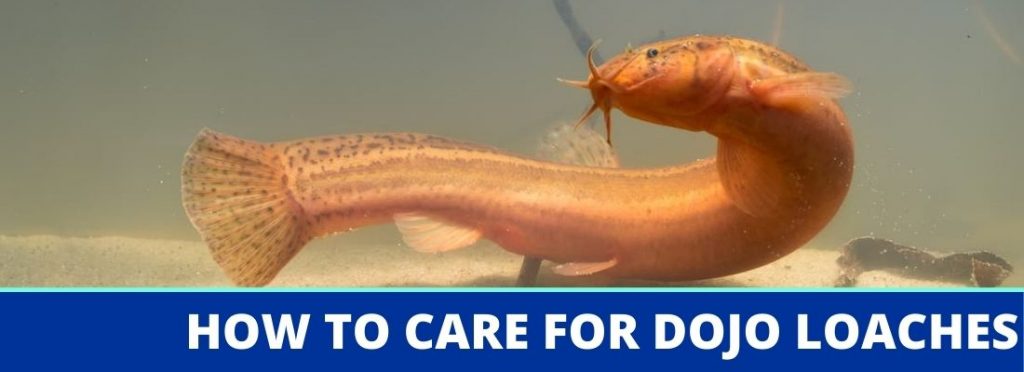Loaches are some of the most interesting freshwater fish for any home aquarium. The different types of different interesting elements for any aquarist, like those of the Dojo – or weather – loach. Let’s take a look at what makes these fishy friends so unique and how to care for them.
Quick Intro to Dojo Loaches
| Family: | Cobitidae or True loaches |
| Scientific Name: | Misgurnus anguillicaudatus |
| Common Names: | Dojo loach, dojo fish, pond loach, oriental loach, Japanese weather loach, weather loach, oriental weatherfish, chinese weatherfish, golden dojo |
| Care Level: | Easy |
Natural Habitat, Identification, and Where to Buy
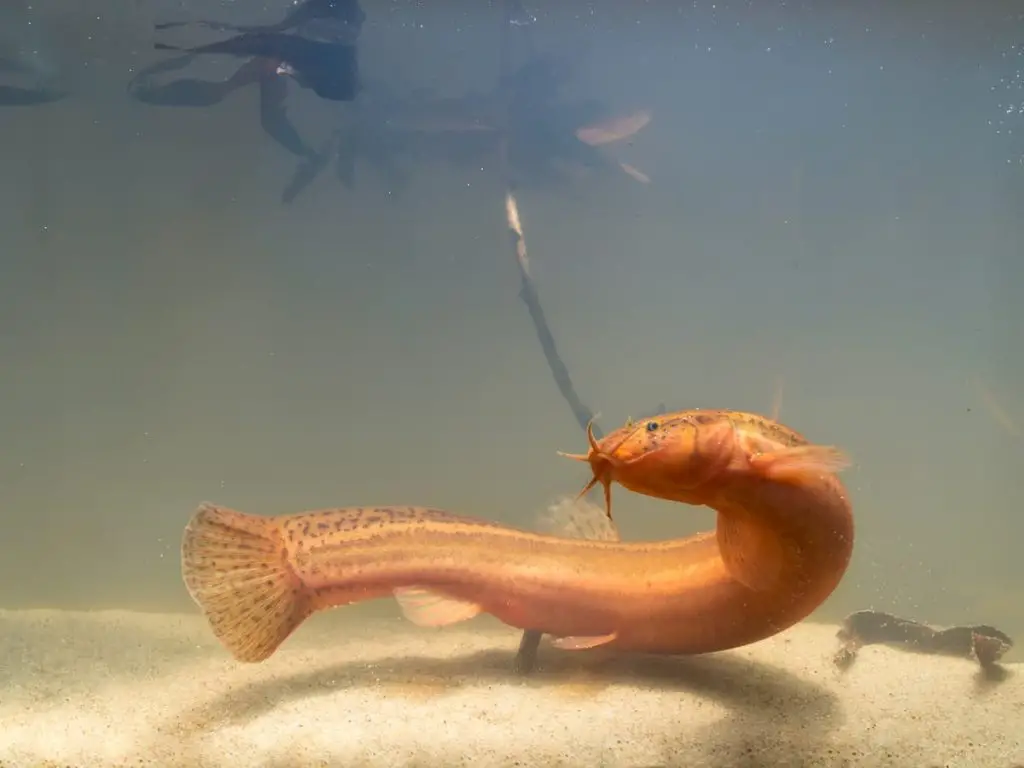
Weather Loach (also known as Dojo or Pond Loaches) is native to countries in Asia such as Japan, China, Korea, northern Vietnam, and Siberia. It inhabits slow-moving shallow waters such as ponds, bogs, streams, and rivers. These waters have a thick amount of plant life with muddy substrates.
This fish species has been successfully introduced to areas such as Italy, Germany, Spain, Uzbekistan, Canada, Australia, and the USA. This species has been able to spread to such a wide variety of areas in part to the commercializing of aquarium husbandry.
Besides being kept as a pet, this fish can also be used as a food source for larger fish.
This species is known to have high endurance and a high capacity for adapting to different conditions, making dojo loach care reasonably easy for most. They are omnivores who are quick to breed and a lack of significant predators has led them to spread quickly. The major downside of this fish’s adaptability is that it has begun to replace native species as it gets introduced to new areas. This has lead to a number of countries prohibiting the importing of this fish unless one has special permission.
If the water the fish is in doesn’t have enough dissolved oxygen, the fish can swim near the water surface and breath in the air.
A unique way this fish deals with water droughts is by digging into the mud. It will dig anywhere from 1-2 meters and will wait until there is water before digging out.
This species is one of the few which will seek out attention and physical contact with its fish keeper.
Optimal Water Conditions for Dojo Loaches
| Water Temperature: | 50-72 F |
| Water Flow Rate: | Moderate |
| pH: | 6.0-8.0 |
| Water Hardness: | 5 to 12 dKH |
Tank Setup
| Minimum Tank Size: | 29 gallons |
| Optimal Tank Size: | 55+ gallon tank |
| Optimal Tank Shape: | Standard rectangular is fine |
| Recommended Filter Type: | High-quality HOB |
Dojo Loaches have specialized aquarium needs. These species tend to stick to the bottom of the aquarium. During the day they will bury themselves in the substrate for sleep, so they need soft sand rather than gravel.
Besides hiding in the substrate, they need a tank with a large amount of rock and driftwood. If there are not enough hiding places in the aquarium the fish will feel unsafe.
It is important to make sure you have covers over the filter. This species likes to explore so without proper covers this species can get stuck inside of the filters.
This fish species is very adaptable and can handle a wide range of water conditions. The pH levels need to be between 6.0 and 8.0 and a water temperature between 64- and 74-degrees Fahrenheit. They require a large amount of water movement so that the water is oxygenated.
The best type of filter for this fish is a canister filter. While this type of filter is more expensive it will eliminate one potential escape route for Houdini-like escape artist.
It is important that you keep the aquarium covered. This species is known for taking any opportunity to escape. If this fish manages to get out of the tank, it can survive on dry land for several hours.
Creating the Landscape
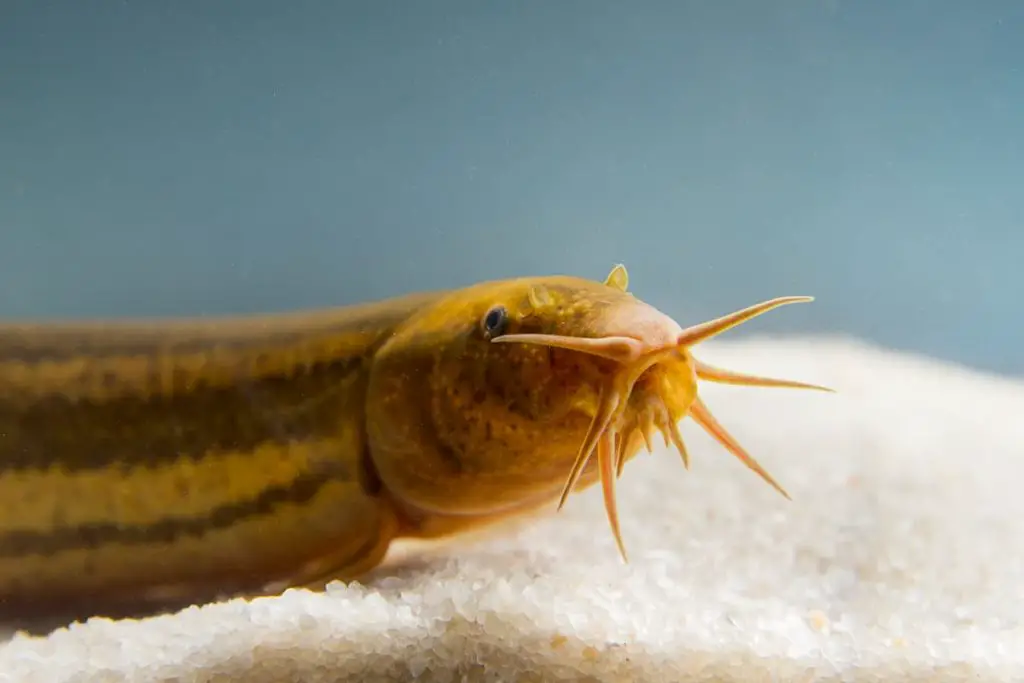
The best substrate for your Loaches is either sand or another type of loose material that they can dig into. It is common for fish keepers to see their loaches buried up to their necks in the substrate. If this fish feels threatened it will go into the substrate to hide. It is common for recently introduced Loaches to hide for a few days until they get used to their new tank.
Loaches are a social fish and need other loaches around to feel safe. It is recommended that they be kept in groups of at least three loaches. If this fish is kept by itself, it will hide and rarely come out during the day.
When this fish is kept in a group then they will become much more social and be out during the day. A sign that your loaches have adjusted to your tank is that they will sometimes lay down next to each other, forming a pyramid.
It is important to make sure your tank has space between the surface of the water and the aquarium lid. This fish will sometimes need to breathe from the atmosphere and there needs to be breathing room.
| Best Plants: | They tend to uproot plants, use with care! |
| Best Lighting: | Low |
| Best Decorations: | Lots of hiding places! Flowerpots, caves, PVC pipes, etc. are great, with sand substrate. |
| Decorations to Avoid: | Anything with sharp or jagged edges, live plants that will be damaged by being uprooted. |
Physiological Considerations for Dojo Loaches
| Size: | Up to 12 inches |
| Lifespan: | Up to 10 years |
| Temperament: | Peaceful |
| Preferred Tank Region: | Bottom |
| Scale Thickness: | No scales. |
| Gill Considerations: | Standard gill concerns |
| Swimbladder Considerations: | Like many fish, they may have issues with swimbladder disorders. They need high-quality water conditions to remain healthy. |
| Fin Shape Considerations: | Nothing special to note. |
The fish tank environment for the Dojo Loach is undemanding. So much so that this is perfect for those who are new to fishkeeping.
For this loach to be happy and healthy, it needs to be kept in cool water. The fish’s lifespan is dependent upon water quality and water temperature. Keep the water temperatures cold and this fish could live upwards of ten years. However, if you let the temperature increase then the lifespan can easily be cut in half.
It is important to have enough space for your fish. Dojo Loach is known to grow upwards of twelve inches.
This species of fish has an elongated body that has small but visible scales, along with a tall but rounded fin. It has an infraorbital spine under its skin. The fish has 10-12 barbels around its mouth.
The fish is known for having yellow or brown eyes that change in color intensity depending on its environment.
The typical fish has a skin color that is light olive green and is speckled with a lot of small spots. It is also known for having two other colors in nature, white and gold. The gold-colored is known as the Golden Dojo.
Society
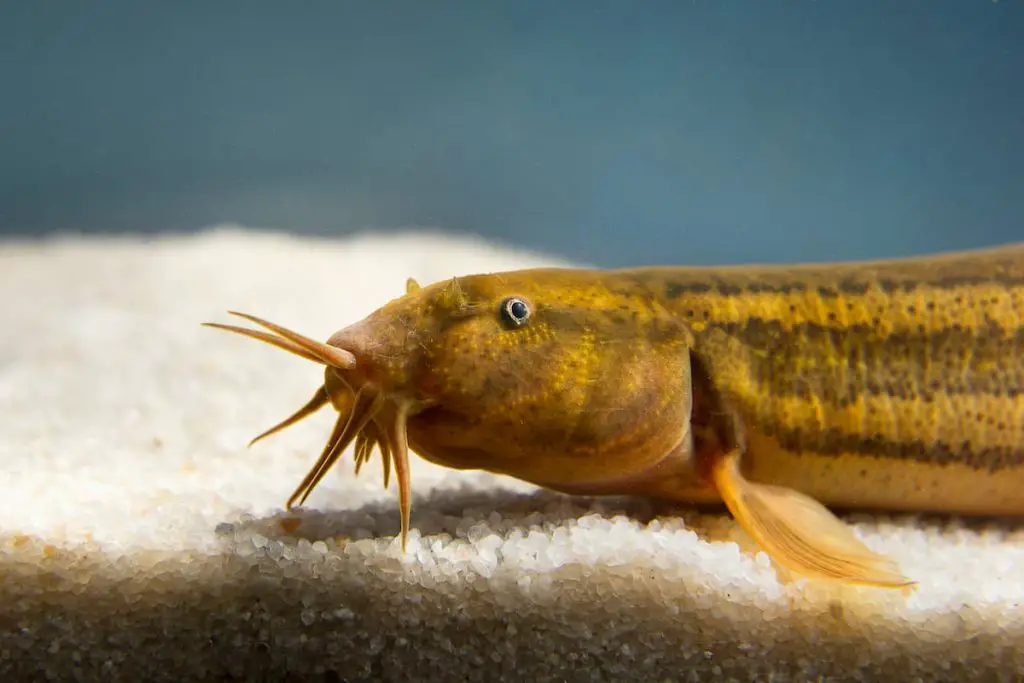
If you want to have your Dojo Loach in a mixed tank, it is important to keep in mind that this is a peaceful fish. It is a social fish that can get along with other peaceful fish. This species can get along with tropical fish, however, it is important to note that Dojo Loach’s will not thrive at the water temperature that tropical fish require.
Dojo Loaches like to have dim light and a low water flow. It is important to pick other fish who have similar needs.
Make sure you avoid housing this species with any known fin-nippers.
Also, it is important to not keep this fish with slower fish, like goldfish.
This fish species like to be near the bottom so they can swim to a hiding place or burrow into the sand. While they are at the bottom of the tank they like to finish up any food dropped by other fish.
If you keep this fish species with others of this species or other similar-looking fish, they will sometimes cuddle up next to one another. It has also been observed that this fish will be more active and social with other similar fish.
- Goldfish
- Zebra danios
- White cloud mountain minnow
- Paradise fish
- Other dojo loaches
Gender, Breeding, and Reproductive Considerations
When it comes to gender differences for the Dojo Loach, the male has distinct physical qualities. The male tends to be longer and have thicker pectoral fins along with having fatty tissue on the body behind their dorsal fins.
The available knowledge on breeding Dojo Loach (or Yoyo Loach) in captivity is limited and incomplete. Farm hatcheries are known to use hormone injections to try and meet the high demand for this fish.
In the wild, the male will hug the female after it does a mating display. The fertilizing occurs during the hugging. Afterward, the female lays eggs and the eggs then sink down into the substrate.
When the female lays eggs, about 100-150 eggs are laid. The eggs themselves are not very stick and are light brown with a diameter of 1,7 to 1.9 mm.
At around 14-16 degrees Celsius, the eggs take around four days to hatch. After the larvae emerge, they have an extra respiratory organ that has external gills.
On the 12th day, the larvae start to eat. They look for foods by the use of a specialized sensory organ that is located around their barbels and mouth.
On their 26th day, their external gills become reduced.
Their juvenile stage starts when the larvae become 30mm long.
Except this, dense network of blood vessels in large pectoral fins and later those in intestinal tract of the larvae also perform additional respiratory function.
Being about 8 mm long on the 12th day of their life the larvae starts to feed. They look for food by means of special sensory organs located around their mouth and on the barbels (they develop very early).
At the age of 26 days old their external gills get completely reduced. Juvenile stage starts when the larvae becomes 30 mm long.
Nutritional Needs
Dojo Loaches are known to a fish that lacks discrimination when it comes to eating and opportunistic meals. These fish are omnivores that will happily eat any food that passes by them in the water. As this species of fish likes to inhabit the bottom of your tank, it is important to make sure any tankmates that occupy the upper levels do not eat all the food and that some reach the bottom of the tank.
Regarding the food itself, it is best to offer a variety of living, dried, and frozen foods. This can be a variety of worms (bloodworms, earthworms, etc.), brine shrimp, and other meat-based foods.
If you feel that your fish are not getting enough food due to their location at the bottom of the tank, it is possible to do targeted feeding. For food that is more liquid, a turkey baster is a good choice. For feeding your fish larger and more solid food, tongs are a great choice. Sinking pellets are another great way to ensure they have enough food.
Pond Loaches are known to become attached to their owner and will enjoy being strokes and even hand-fed by their owner.
- Algae
- Daphnia
- Insect larvae
- Blood Worms
- Earth Worms
- Brine Shrimp
- Other small crustaceans
| Best Sustenance Food Type: | A blend of plant and proteins. |
| Additional Food For Optimal Health: | Nothing of note. |
| Special Foods and Considerations for Best Color and Growth: | A good blend of vegetation and animal protein will help their coloring. |
| When and How Often to Feed Fish Based on Life Cycle: | Ideally, feed them various food types throughout the day, rather than all at once. |
Common Diseases and How to Avoid and Treat Them
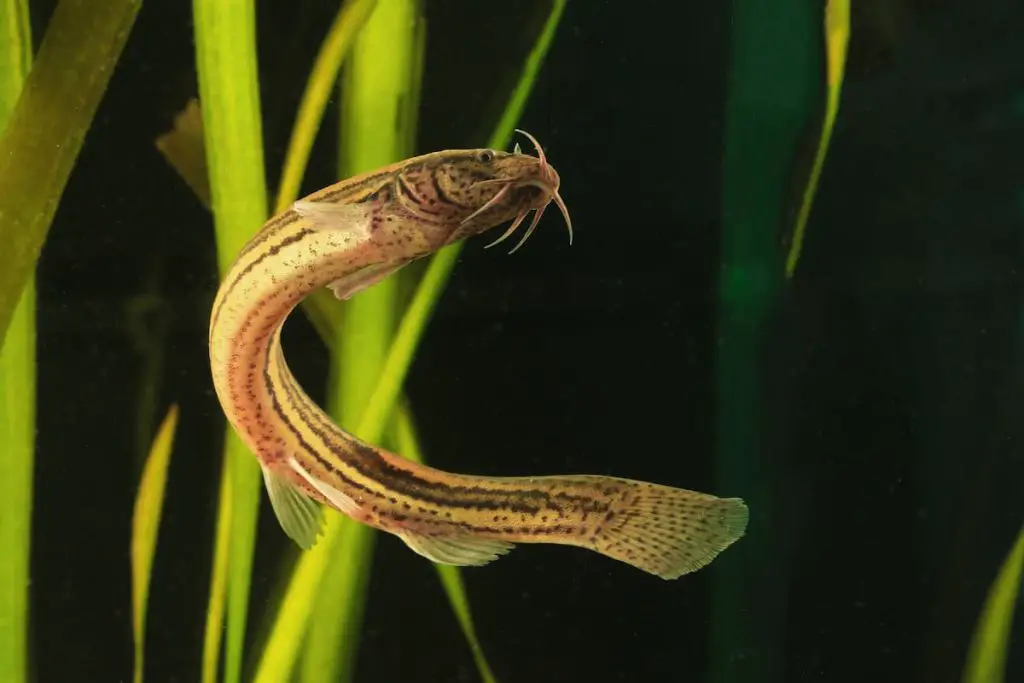
Dojo Loach is known to be hardy fish; however, they are more susceptible to disease than other aquarium fish.
Their scales are thinner, and more faint compared to similar aquarium fish. Their scales make it important to be careful when introducing this species into a shared tank. This fish species is overly sensitive to medications used to treat common fish diseases. Additionally, cold water and water changes will cause fish stress and can contribute to its disease.
The most common ailment Loach will deal with is called Ich. This disease is a parasite that causes white spots. As sensitive as this fish is to most medications, they typically only need half the dosages as other fish for treatment.
Skinny disease is caused by internal parasites. Fish affected by this are unable to maintain weight even if they are eating a high diet. This disease can be treated using proper medications.
When your fish have any of these symptoms it is important to isolate them in a hospital tank so that they will spread the disease to other fish. Since loaches are so sensitive it is important to not put mediation into water that would affect other fish since they are so sensitive.
| Best Antibiotics: | Store-bought medications. |
| Treatments to Avoid: | Overdosing with medication. |
| Food Recommendations When Sick: | A good balance of protein and plant matter. |
| Hospital Tank or Isolation Within the Community Tank: | Hospital tanks are needed when these guys are ill. |
2 Facts About Dojo Loaches
- The Weather Loach got its name due to how this fish responds to even slight changes in barometric pressure.
- While kept in aquariums the Dojo Loach will only grow to about six inches while in nature they are known to reach up to twelve inches in length.
